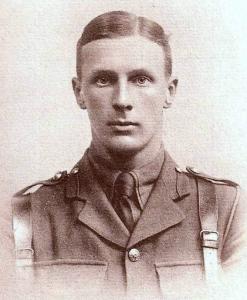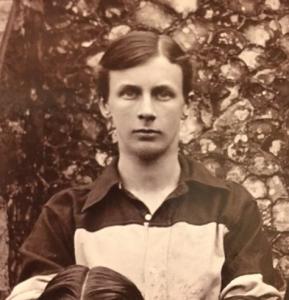
|

|
| 2nd Lieutenant Wilfred GARLAND | |
|
C Company, 7th (Service) Battalion Oxfordshire and Buckinghamshire Light Infantry Date of birth: 8th August 1891 Date of death: 8th May 1917 Killed in action aged 25 Commemorated on the Doiran Memorial in Greece |

|
| Wilfred Garland was born at 74 Potter Newton Lane, Leeds in Yorkshire on the 8th of August 1891 the second son of Henry Garland, a solicitor, and Margaret Edith (nee Wilkinson) Garland later of 9 Willes Terrace, Leamington Spa in Warwickshire. He was educated at Charney Hill School at Grange-over-Sands in Cumbria and at Lancing College where he won an Exhibition and where he was in Olds House from September 1905 to December 1910. He was a member of the Football XI in 1909/10, became a Prefect in 1910 and was editor of the Lancing College Magazine in 1909. He served as a member of the Officer Training Corps from 1907 to 1910, achieving Certificate A and part of Certificate B. He went on to Keble College Oxford in October 1911 where he achieved 4th Class Moderations in 1913. He was a member of the Oxford University Officer Training Corps from 1911 to 1914. While still at Keble he applied for a commission in the Oxfordshire and Buckinghamshire Light Infantry on the 18th of November 1914. He had undergone a medical examination at Carlisle on the 21st of September 1914 at which it was recorded that he was five feet ten and five eighths of an inch tall and that he weighed 137 1/2lbs. He was commissioned as a 2nd Lieutenant in the 7th Battalion Oxfordshire and Buckinghamshire Light Infantry on the 24th of November 1914 and was posted to C Company. He embarked with his battalion from Folkestone on the 21st of September 1915 and landed at Boulogne later the same day. On the 11th of November 1915 he embarked at Marseilles and they landed at Salonica on the 26th of November. He was admitted to 78 Field Ambulance at Pyrexia on the 7th of February 1916 and was admitted to 25 Casualty Clearing Station on the same day. He was transferred to 29 General Hospital on the 5th of March. His father received the following telegram dated the 24th of March 1916: - "Report just received states 2/Lt W. Garland Ox and Bucks Light Infantry admitted 29 General Hospital , Marathon Road Camp Salonica March 5th. Case then not diagnosed. Further information wired when received." He was discharged from hospital on the 10th of April after receiving treatment for appendicitis. He was admitted to 29 General Hospital on the 28th of August 1916 suffering from displaced cartilage and returned to the 26th Infantry Base Depot on the 19th of September 1916. He re-joined his battalion in the field on the 25th of September 1916. On the 8th of May 1917 the 7th Battalion Oxfordshire and Buckinghamshire Light Infantry was resting at Torquay Camp in preparation for an attack that night. They were to be in support of an attack on 1,000 yards of Bulgarian held trench connecting Lake Doiran and Petit Couronne. No man's land was relatively flat but was marked with a number of deep ravines which were to make the crossing more hazardous than was already the case. A few gas shells fell into the camp as the men waited but by 11.30pm B and C Companies were forming into waves as their turn came to move forward to the attack. The three assaulting battalions had succeeded in gaining their objectives in the centre of the attack with the battalions on their flanks being held up by enemy fire. As the Ox and Bucks formed up they came under fire from enemy trench mortars which caused a number of casualties particularly among officers and NCOs, including Major A.D Holman, who was in command of the assaulting companies. Under an accurate barrage from the supporting British artillery the leading companies were able to crawl up to within 20 yards of the enemy trenches. When the barrage lifted the Bulgarian defenders were quickly disposed of and B Company readied themselves to attack the next Bulgarian position, trenches known as Z33 and Z34; the battalion bombers spread out on their flanks in support. While they were waiting to move forward B Company was hit by a heavy enemy artillery barrage which lasted about twenty minutes and caused a large number of casualties including their company commander. As a result of this 2nd Lieutenant Garland and his platoon from C Company joined B Company where Garland took command. When B and C Companies were able to move forward they took their second objective but were hit by such heavy artillery fire they were literally blown out of the 80 yards of enemy trench they had taken. Wilfred Garland was last seen at the junction of trenches Z33 and Z34 helping to drive back an enemy counterattack by throwing bombs. After further heavy fighting involving all four companies, the men of the Ox and Bucks had taken their objectives and dug in. Orders were received to withdraw at 9.30am but it was 3pm before the more than 100 stretcher cases could be evacuated. Of the sixteen officers and five hundred and thirty men who went into the attack fifteen officers and four hundred and fifty six other ranks became casualties in the battalion's worst day of the war. Wilfred Garland was listed as being among the missing. His father received the following telegram dated the 15th of May 1917: - Regret to inform you 2/Lt. W. Garland Ox and Bucks Light Infantry reported missing between eighth and ninth May Balkans. This does not necessarily mean he is either killed or wounded. Any further reports sent immediately received." He received a further telegram dated the 18th of May 1917: - "Deeply regret to inform you 2/Lt. W. Garland Oxford & Bucks Light Infantry previously reported missing is now reported missing believed killed in action. The Army Council express their sympathy." A number of statements were taken from eyewitnesses to the attack to establish the fate of Wilfred Garland. Statement of Private F. Trinder, 7th Battalion Oxfordshire and Buckinghamshire Light Infantry: - “On the morning of 9th May 1917 just after dawn I crawled to the top of Petit Couronna, with a Sergeant of the Royal Berkshire Regiment, to identify a dead body thought to be that of Lieut. Garland. We were able to get sufficiently close to see him distinctly. It was Lt. Garland, and I am quite sure from the way he was lying, and from his appearance that he was dead.” Statement of Company Sergeant Major B. Cruich: - "I certify that on the morning of 9th May 1917 following the attack by the 7th Royal Berks in conjunction with 7th Oxford & Bucks I discovered the body of the late Lieut. Garland. From the above mentioned officer I removed some personal effects from his pocket which were duly handed in to Oxfords and Bucks orderly room." Lieutenant Colonel P. Villiers, Commanding Officer of the 7th Battalion Oxfordshire and Buckinghamshire Regiment reported the following from the field on the 20th of May 1917:- Lieut. C. Baker was hit very badly by a shell, and from statements made of those who were with him, it was thought that it was not possible for him to live. Lieut. F.A. Durno-Steele was hit twice by Trench Mortar shell, and during the operations his identity disc, was taken from a dead Bulgar. 2/Lieut. W. Garland was badly wounded by Trench Mortar shell and papers and sketches were taken from him (men declare it was not possible for him to live). All three officers were engaged in operations i.e. an attack on the enemy position, and on withdrawing were left on the field, it being found impossible to recover them. For his work that night he was mentioned in Lieutenant General G.F. Milne despatches of the 25th of November 1917. His father applied for his medals in September 1921. He is commemorated on the war memorial at Keble College Oxford. |
|
 | |
| Olds House |
Back